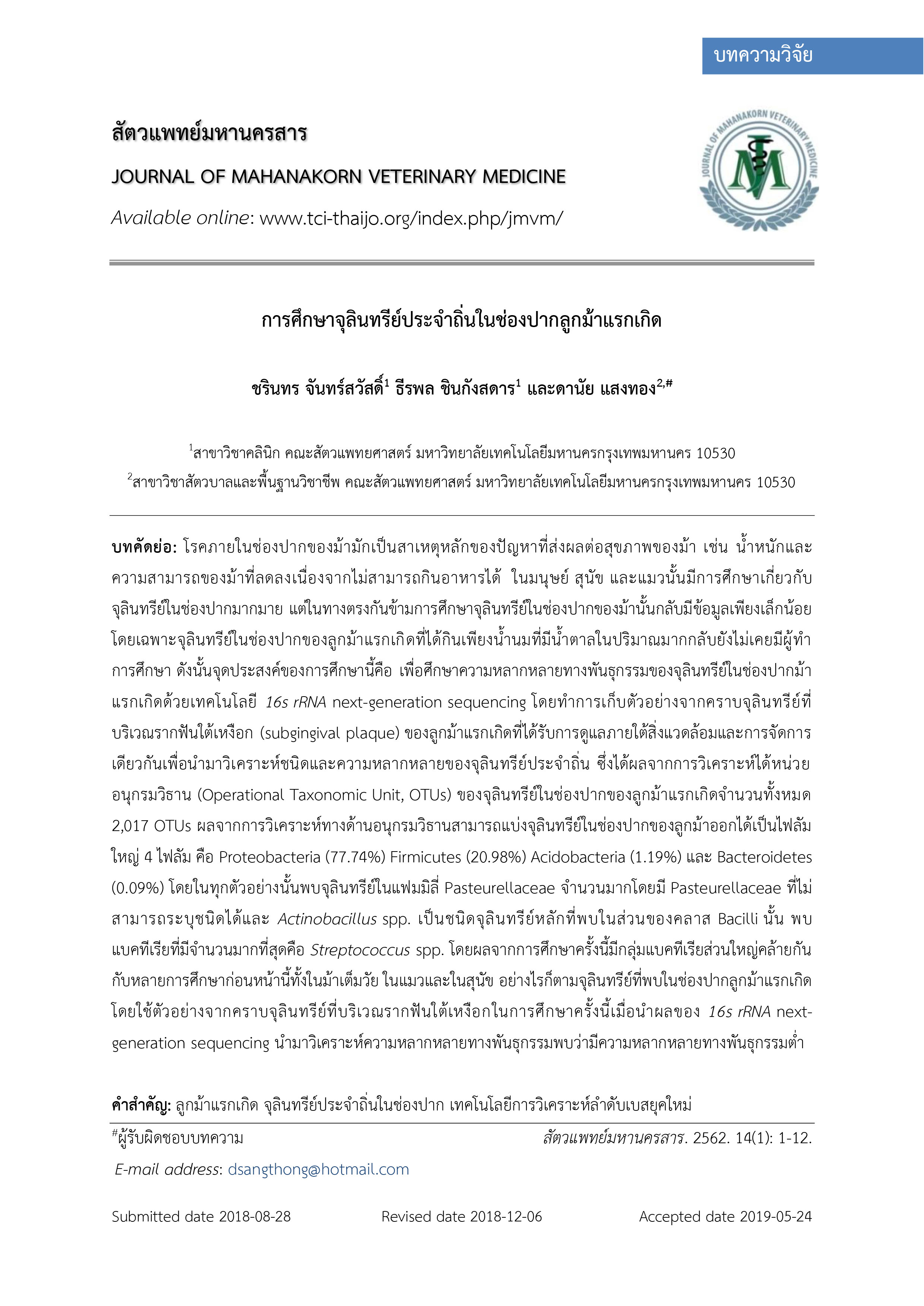The Study of Newborn Foal Oral Microbiota Diversity
Main Article Content
Abstract
Equine oral disease is the underlying cause of many general disorders, such as weight loss and poor performance. There are plenty of oral microbiology studies such as human, dog and cat. In contrast, there have been only a few studies dedicated to equine oral microbiology and the investigations of oral bacteria in a neonatal foal which feeding on milk contain a higher amount of sugar has never been reported. The aim of this study was to investigate the microbial diversity in healthy subgingival niches in newborn foal's oral cavities using Next-generation sequencing (NGS) of 16S ribosomal RNA (16s rRNA) gene method. The subgingival plaque of three healthy Thoroughbreds cross newborn foals that are raised in the same environment and management were collected for analysis. A total of 2,017 (Operational Taxonomic Unit, OTUs) presented; 903 OTUs for F1, 495 OTUs for F2 and 709 for F3, representing the four mainly different bacterial phyla; Proteobacteria (77.74%), Firmicutes (20.98%), Acidobacteria (1.19%), Bacteroidetes (0.09%). Pasteurellaceae was highly abundant; unclassified Pasteurellaceae, as well as Actinobacillus spp., were observed in all sample. Within the class Bacilli, the most dominant genus Streptococcus spp. was observed. The result in this study is similar to the major groups of bacteria that have found in the previous studies in adult horse also, consistent with the result in cats and dogs. However, the microbial diversity in healthy subgingival niches in newborn foal's oral cavities using next-generation 16S rRNA gene sequencing method was low.
Article Details
References
Chinkangsadarn, T. 2015. Clinical and microbiological aspects of periodontal disease in horses in South-East Queensland, Australia. The University of Queensland.
Cox, A., P. Dixon, and S. Smith. 2012. Histopathological lesions associated with equine periodontal disease. Vet. J. 194: 386-391.
Dorsch, M., D. Lovet, and G. D. Bailey. 2001. Fusobacterium equinum sp. nov., from the oral cavity of horses. Int. J. Syst. Evol. Micr. 51: 1959-1963.
Gao, W., Y. Chan, M. You, D. C. Lacap-Bugler, W. K. Leung, and R. M. Watt. 2016. In-depth snapshot of the equine subgingival microbiome. Microb. Pathog. 94: 76-89.
Kennedy, R., D. F. Lappin, P. M. Dixon, M. J. Buijs, E. Zaura, W. Crielaard, L. O'donnell, D. Bennett, B. W. Brandt, and M. P. Riggio. 2016. The microbiome associated with equine periodontitis and oral health. Vet. Res. J. 47: 49.
Marsh, P. D. 1994. Microbial ecology of dental plaque and its significance in health and disease. Adv. Dent. Res. 8: 263.
Oh, C., K. Lee, Y. Cheong, S. W. Lee, S. Y. Park, C. S. Song, I. S. Choi, and J. B. Lee. 2015. Comparison of the oral microbiomes of canines and their owners using next-generation sequencing. PloS one. 10: e0131468.
Peet, R., D. Main, J. Cronin, and A. Sier. 1977. Pasteurella haemolytica infection in two neonatal foals. Aust. Vet. J. 53: 152-152.
Saxegaard, F. and R. Svenkrud. 1974. Pasteurella haemolytica associated with pneumonia in a foal. A case report. Acta Veterinaria Scandinavica. 15: 439.
Socransky, S., A. Haffajee, M. Cugini, C. Smith, and R. Kent. 1998. Microbial complexes in subgingival plaque. J. Clin. Periodontol. 25: 134-144.
Sohn, K., K. Sohn, K. M. Kalanetra, D. A. Mills, and M. A. Underwood. 2016. Buccal administration of human colostrum: impact on the oral microbiota of premature infants. J. Perinatol. 36: 106-111.
Sturgeon, A., S. L. Pinder, M. C. Costa, and J. S. Weese. 2014. Characterization of the oral microbiota of healthy cats using next-generation sequencing. Vet. J. 201: 223-229.
Takahashi, N. Microbial ecosystem in the oral cavity: metabolic diversity in an ecological niche and its relationship with oral diseases. International Congress Series, 2005. Elsevier,p. 103-112.
Wilson, W. and J. Madigan. 1989. Comparison of bacteriologic culture of blood and necropsy specimens for determining the cause of foal septicemia: 47 cases (1978-1987). J. Am. Vet. Med. A. 195: 1759-1763.


